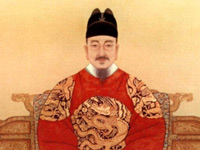Sejong the Great (1397-1450)

Death and Legacy
Sejong was blinded years later by diabetes complications that eventually took his life in 1450. He was buried at the Yeong Mausoleum (영릉; 英陵). His successor was his first son, Munjong. Sejong judged that his sickly son, Munjong, was unlikely to live long and on his deathbed asked the Hall of Worthies scholars to look after his young grandson, Danjong. As predicted, Munjong died two years after his accession, and political stability enjoyed under Sejong disintegrated when Danjong became the sixth king of Joseon at the age of twelve. Eventually, Sejong's second son, Sejo, usurped the throne from Danjong in 1455. When the six martyred ministers were implicated in a plot to restore Danjong to throne, Sejo abolished the Hall of Worthies, and executed Danjong and several ministers who served during Sejong's reign.
The street Sejongno and the Sejong Center for the Performing Arts, both located in central Seoul, are named after King Sejong.
King Sejong is on the Korean 10,000 won bill, along with the various scientific products made under his reign.
In early 2007, the Republic of Korea government decided to create a special administrative district from part of the present Chungcheongnam-do Province, near what is presently Daejeon. The district will be named Sejong Special Autonomous City.
HISTORY

RESOURCES
This article uses material from the Wikipedia article "Sejong the Great (1397-1450)", which is released under the Creative Commons Attribution-Share-Alike License 3.0.
© Stories Preschool. All Rights Reserved.








